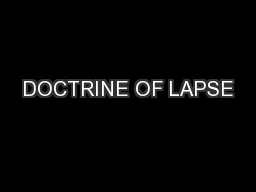

Grade 8 INTRODUCTION The GovernorGeneral Lord Dalhousie was a great imperialist He adopted a number of methods to build the British Empire in India Some of the methods he adopted were War Punjab and Burma ID: 362969
Download Presentation The PPT/PDF document "DOCTRINE OF LAPSE" is the property of its rightful owner. Permission is granted to download and print the materials on this web site for personal, non-commercial use only, and to display it on your personal computer provided you do not modify the materials and that you retain all copyright notices contained in the materials. By downloading content from our website, you accept the terms of this agreement.
Slide1
DOCTRINE OF LAPSE
Grade 8Slide2
INTRODUCTION
The Governor-General, Lord Dalhousie was a great imperialist.
He adopted a number of methods to build the British Empire in India.
Some of the methods he adopted were:
War - Punjab and Burma
Doctrine of Lapse – Satara, Jhansi and Nagpur
Annexation on grounds of maladministration - AwadhSlide3
DOCTRINE OF LAPSE
According to the Doctrine of Lapse, all subordinate states (subsidiary states and states created by the English) where rulers died without a biological male heir, would automatically ‘lapse’, or, pass into the hands of the
British Administration.
Rulers were not allowed to adopt sons (although tradition allowed them), without the permission of the Company.Slide4
Lord Dalhousie applied this policy to Satara, Jhansi and Nagpur.
The families of former rulers were pensioned off and their territories annexed.
The annexation of these states caused widespread resentment among the Indian rulers.
This was one of the factors responsible for the outbreak of the Revolt of 1857.